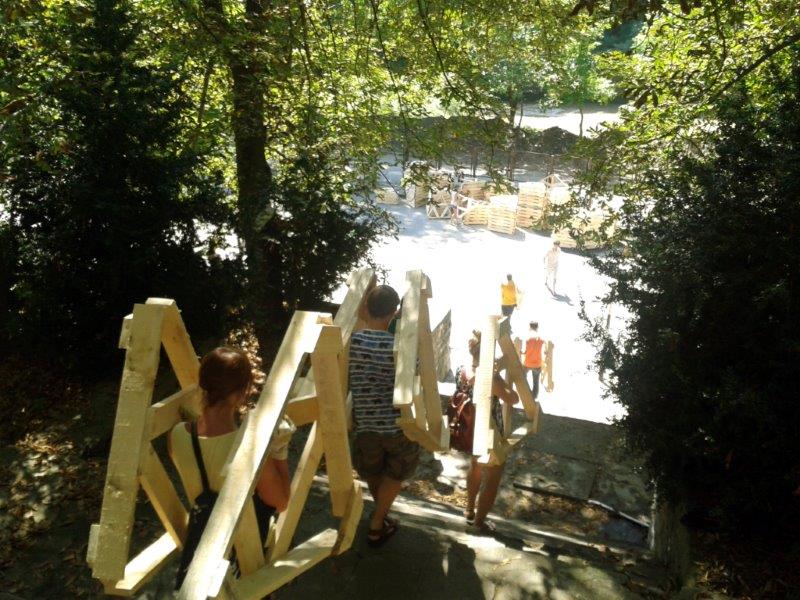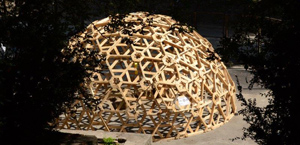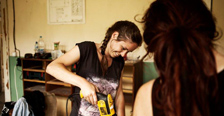>>>>>>>
Geodesic Workshop @ Symbioza, 34th EASA Festival
ATTENCIÓN: “GEODESIC GEOMETRIES” IS THE WORKSHOPS WE’VE BEEN TEACHING SINCE 2012, THE RESEARCHES WE’RE PAUSE-LESS DEVELOPING FROM THAT TIME AND THE PROJECTS THAT WE’VE BEEN REALIZING WITH THOSE TECHNIQUES EVOLUTION. WE SUGGEST TO STUDY ALL THESE ASPECTS TO HAVE A MORE COMPREHENSIVE VIEW OF THE TOPIC.
Background: “low-tech” geodesic domes
During recent years we activated, around our interest on geodesic geometries, a cycle of research, prototyping and application of the obtained results for the implementation of real projects.

There are different constructive techniques applicables to geodesic geometries, each one with different levels of technological exigency, materials and infrastructures requirement. Our goal is to simplifying them all, thus we structure our work so that the different phases of the cycle alternate and provide feedback one another in an evergrowing spiral towards the “low-tech”.
Gradually this research was established as one of the main focus of study and experimentation in Ctrl+Z.
Generally we’ve been working looking for solutions that could be implemented using wood pallet as the base material for creating living or work places, individual or communitarian, trough selfconstruction. Therefore, although we built prototypes with many other techniques, we were mainly researching and experimenting at real scale with the “Brujodesic™” technique and the “Wooden, dual angle, knotless”.
selfconstruction. Therefore, although we built prototypes with many other techniques, we were mainly researching and experimenting at real scale with the “Brujodesic™” technique and the “Wooden, dual angle, knotless”.
Before the summer we had reached, for both, a level of simplification that was not possible for us to proceed without before check on the field, and with untrained persons, the application of our intuitions and advances already proposed for the low-tech development of each constructive method.
Symbioza- 34º “European Architecture Students Assembly” festival
It was exactly at this time when we had constancy of the call for “Symbioza”, the 34º Festival del Easa (European Architecture Students Assembly) that was going to be celebrate in Veliko Tarnovo (Bulgaria) with the estimated presence of 550 students and tutors coming from over 50 countries.
This annual festival was celebrated for the first time in Liverpool in 1981 by local students determined to organize an event that could revolutionize the young Europeans architect’s panorama. Since then has been held every year in a different locality, always without losing its independent and cutting edge spirit.
It immediately seemed us the perfect occasion to test the “low-tech” protocols and the coding of the building systems, according to their technological requirements and available materials, which we were implementing.
 The festival duration suited the times we considered necessary for the basic and some of the advanced knowledge transfer over this type of constructions, plus we had raring to share this knowledge with the worldwide youth.
The festival duration suited the times we considered necessary for the basic and some of the advanced knowledge transfer over this type of constructions, plus we had raring to share this knowledge with the worldwide youth.
So we sent our proposal that was accepted by the organizing team.
Being the festival based on volunteer teachers, we contacted various institutions.
The “Istituto Italiano di Cultura di Sofia” has funded and supported our initiative that has also counted on the economical support of the “Colegio Oficial de Arquitectos de Sevilla” and with the generous help of Massimo Mazzone.
Ctrl+Z’s proposal realization
During the different phases of presentation of the workshops, almost 40, we were frequently questioned on if we ever built a geodesic dome or was some king of tryout. This put manifests to us the very experimental nature of festival to which we had to adapt during development of our proposal.
After a first introduction to the mathematical and practical concepts of the geodesics and presentation of the different existing constructive systems, of the different qualitative and quantitative options that had been prepared, evaluated the vocations and commitment that the group wanted devote to the workshop, as well as the pro and contras of each system, students chose learn and build an 8 meter diameter “Brujodesic™” dome and began to face the task of drawing templates and pieces, for the realization of the triangles.
 In this phase we decided place ourselves in an empty room in the second floor of the bar’s building. Despite the obvious disadvantages of working in interior, for example in the acoustic aspect, finally it seemed the most appropriate choice as it allowed us to avoid the possible rains and the general work zones didn’t seem to us capable to ensure the group security, for the presence of many people using heavy machineries contemporaneously and each one his own way.
In this phase we decided place ourselves in an empty room in the second floor of the bar’s building. Despite the obvious disadvantages of working in interior, for example in the acoustic aspect, finally it seemed the most appropriate choice as it allowed us to avoid the possible rains and the general work zones didn’t seem to us capable to ensure the group security, for the presence of many people using heavy machineries contemporaneously and each one his own way.
In addition work separately allowed us avoid distractions, organize and sort the workspace and work itself according with our demands, while also facilitated communication and the knowledge transfer.
On first day 2½ triangles where prepared, 9 on the second, 22 on the third and the fourth almost 60. Insecurities and complications that at first accompanied each operation, even the simplest, gradually transformed into an assembly line with several operations for which students were finding new and better forms to carry them out, to coordinate always better, interchanging and perfecting them day after day.
After the first days also the tasks of “quality control”, of “control of production of parts flow”, and those of general organization, were delegated and, after a logical and natural initial overwhelm, the group assumed them pretty well.
In general in this first phase the main challenge was for us organizing the workshop such that students could enter gradually and safely in the logic of construction, slowly increasing the complexity of the tasks and workloads, without losing the interest and enthusiasm during the process.
The tasks were programmed so that should turn each day more complex and treated to show the following steps to put into evidence, in each moment, the reasons for which we were inviting them to perform a task in a certain way.
 Finally after a week we completed the production of the triangles that were moved down to the mounting location, the school that hosted the festival playground, with the help of several members of other workshops, with who we had already established synergies of help, materials and tools exchange during the week.
Finally after a week we completed the production of the triangles that were moved down to the mounting location, the school that hosted the festival playground, with the help of several members of other workshops, with who we had already established synergies of help, materials and tools exchange during the week.
The assembly was developed over three days, the truth is that, having a lot of spare time, we decided to take it easy. Even so, and being the only workshop led by only one tutor and one of the cheapest around the festival, the building was completed three days in advance. From the beginning no one gave much credit to our group, also because working inside, we did not give many clues about our progress.
El first day we put together the structure at ground level, the second was passed to the highest parts, on the third a door was opened and some possible details were exemplified.
During these phases Nedyalko, a neighbor of the area that had showed his interest for the dome and had visited us on different occasions during production of the triangles, as well as Mario, Martin and Georgi joined the group.
Afterfestival dome donation
The objective of our initiative never was the construction of a dome, an object, but knowledge transfer on how to build not only this, but geodesic domes in general. The built object was just a necessary tool for the proposed teaching activity.
Our intention for the physical dome was that it could be useful to someone once the workshop was over.
 However the organization offered it, nor the town hall or the local university demonstrated interest for it during the process, probably they did not believed in our proposal. However when they saw it finished they quickly changed opinion and asked it borrowed to expose it few weeks near the monument to the Asen brothers, in the main square of the city. Once the festival closed down Victoria Paova, one of the workshop student, coordinated the disassembly, transport and reassembly successfully, thus demonstrating having received appropriate formation to develop those tasks.
However the organization offered it, nor the town hall or the local university demonstrated interest for it during the process, probably they did not believed in our proposal. However when they saw it finished they quickly changed opinion and asked it borrowed to expose it few weeks near the monument to the Asen brothers, in the main square of the city. Once the festival closed down Victoria Paova, one of the workshop student, coordinated the disassembly, transport and reassembly successfully, thus demonstrating having received appropriate formation to develop those tasks.
They also asked its donation, but meanwhile we agreed to donate it to Nedyalko that had participated actively in entire assembly process, acquiring the necessary knowledge to unmount it, reassemble and consolidate it in its definitive localization.
At the same time he had earned, with the developed work, the right to receive it for free and, in addition, we felt certain closeness with him and his plan of using it as an open to the public space for yoga and teaching in a nearby mountain locality.
Considerations and conclusions
Two years after the first real scale application of “Brujodesic” technique in “Marcello`s house” we got build in the same time a dome of almost 3 times the volume, with 1.5 times the triangles, with a team formed by totally unrelated to the technique and to selfbuilding processes persons, using the material provided by the organizers (we had even to exchange it with another workshop before starting) and available tools that really did not match those of the list of requirements compiled.
So we had to face greater complexities and challenges. By overcoming them so smoothly we demonstrate the adaptability of the constructive system we are developing and, thanks to its simplicity, its ability to empower groups of people in a very short time.
Being able to successfully check the results of our research encourages us to follow in the development of the low-tech focus of this technique, that don’t require neither intermediate structures to ensure its stability during construction, nor mechanical means, as cranes, that would nullify the all the main advantages of system regarding simplicity, independence, economicity and empowerment.
In change the “Brujodesic” system can be implemented with just saw, screwdriver, bevels and pencils.
A part of those personal considerations the success of workshop, understood as teaching activity, will only be measurable by if and how the participants will give use to the acquired knowledge. We hope to receive soon news and photos of the domes that they’ve designed and built.
Próximos objetivos: vocaciones y deseos
In future we would like to be able to develop a manual about this technique and in general on the wooden geodesic domes. Despite the many digital sources at disposal today, we detect that the information available is very few, often very bad, incomplete and too much times even misleading.
To face the time dedication demand that compiling this guide would require we’re thinking about a crowdfounding system to finance the initiative and the activation of various synergies with public and private institutions.
Meanwhile we are starting to plan the 2015 workshops, both in Europe and Latin America. We invite the institutions or associations interested in organize a workshop and also the people interested in participate and learn these techniques, to contact us: info@control-zeta.org
 Students:
Students:
Afonso Miranda (Portugal), Alexander Tibari (Moldavia), Alina Sidarevich (Belarus), Ana Bertol (Spain), Anna Maslova (Russia), Cecile Vendeure (France), Elizaveta Chuhlantseva (Russia), Eva Logonder (Slovenia), Marcela Raczova (Slovakia), Marko Simsio (Finland), Nastya Belousova (Russia), Sandra Hurek (Poland), Victoria Paeva (Bulgaria).
Acknowledgements:
RuralBoxx, NoSoloPaja, Mario Meshkov, Martin Angelov, Georgi Komsalov, Paolo Grandissimo, every and each one of the Easa Bulgaria members and the volunteers who made Symbioza possible. Hope to see you soon, obviously never at EASA Malta!
Further information:
Facebook – Galería de imágenes
Idaaf – Online architecture, design and arts magazine
Os we also present one small sample of photo by the architectural photographer Alexandra Kononchenko, to see all her work we invite you to visit her galery.




November 2014, the destruction:
Even before our arrival in Bulgaria we were aware that it would have been impossible for the organization of Symбиоза to deal with the management and maintenance of all the workshops products, after the enormous effort they performed to develop the festival.
Our idea was anyway to collaborate with some local social initiative that would receive and valorize, through its use, the produced dome.
After offering in vain a dome that still din’t exist to several institutions, we found a recipient and sign a legal agreement with the organizers and with him for the free transfer of the produced dome. The agreement fixed the delivery for the 3rd of August, once the festival ended, and so we reserved a day for disassembly and found a transport to take it to its final location, where it would have been completed and consolidated.
We where ready for it when the organizers asked us to wait.
leave the dome, they wanted to move it and use it to promote their initiatives, and the city all wanted it in an iconic square to promote their candidature for European Cultural Capital.
Finally, to help the organizers, we accepted this request and we signed a new agreement that fixed the delivery between 19th and 31th of August.
Once in Seville, despite all possible pressures exercised by Ctrl+Z, those dates were extended to infinity. So the dome, without being finished and protected, was left in the square exposed to the elements for more than three months until the European Capitality was assigned to another city, then the dome was demolished we ignore if in a rage attack or in a clumsy attempt to disassembly.
 In one way the city hall conceived the dome just as exhibition object and didn’t care to protect and disassembly it properly, in the other the organizers of the festival were unable to measure their forces which has led to the destruction of many of the projects undertaken during the festival, and did not meet the deadlines agreed with us.
In one way the city hall conceived the dome just as exhibition object and didn’t care to protect and disassembly it properly, in the other the organizers of the festival were unable to measure their forces which has led to the destruction of many of the projects undertaken during the festival, and did not meet the deadlines agreed with us.
Given the scenario would be too easy to blame others, but in Ctrl+Z we prefer to reflect on our part of responsibility and lear from it. We shouldn’t have yield to pressure of the organizers, when we had a truck ready to move it. We should have acted differently to prevent the dome to be used merely as a decorative object, which has served to beautify the city until last, and then discarded.
Recognizing all the efforts produced by the organizers, our intention is to invite the EASA assembly to reflect on the dynamics that accompany their festivals to prevent similar situations in future editions.
Find their way to put in value not only the intangible heritage generated by the contemporary presence of students and proposals from all across Europe, but to take advantage in a more durable and efficient way of those social and economical energies invested by all participants and of the infrastructures and prototypes produced during the festivals.
![]()


































